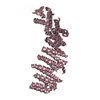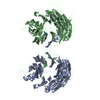+ Open data
Open data
- Basic information
Basic information
| Entry | Database: PDB / ID: 4u1c | ||||||
|---|---|---|---|---|---|---|---|
| Title | Crystal structure of the eIF3a/eIF3c PCI-domain heterodimer | ||||||
 Components Components |
| ||||||
 Keywords Keywords |  TRANSLATION / TRANSLATION /  translation initiation / translation initiation /  eIF3 complex / PCI-domains eIF3 complex / PCI-domains | ||||||
| Function / homology |  Function and homology information Function and homology informationeukaryotic translation initiation factor 3 complex, eIF3e / eukaryotic translation initiation factor 3 complex, eIF3m / translation reinitiation / incipient cellular bud site / multi-eIF complex / eukaryotic translation initiation factor 3 complex / eukaryotic 43S preinitiation complex / formation of cytoplasmic translation initiation complex / eukaryotic 48S preinitiation complex / Formation of the ternary complex, and subsequently, the 43S complex ...eukaryotic translation initiation factor 3 complex, eIF3e / eukaryotic translation initiation factor 3 complex, eIF3m / translation reinitiation / incipient cellular bud site / multi-eIF complex / eukaryotic translation initiation factor 3 complex / eukaryotic 43S preinitiation complex / formation of cytoplasmic translation initiation complex / eukaryotic 48S preinitiation complex / Formation of the ternary complex, and subsequently, the 43S complex / Translation initiation complex formation / Ribosomal scanning and start codon recognition / L13a-mediated translational silencing of Ceruloplasmin expression /  translation initiation factor binding / translational initiation / translation initiation factor binding / translational initiation /  translation initiation factor activity / cytoplasmic stress granule / translation initiation factor activity / cytoplasmic stress granule /  mRNA binding / mRNA binding /  cytoplasm cytoplasmSimilarity search - Function | ||||||
| Biological species |   Saccharomyces cerevisiae (brewer's yeast) Saccharomyces cerevisiae (brewer's yeast) | ||||||
| Method |  X-RAY DIFFRACTION / X-RAY DIFFRACTION /  SYNCHROTRON / Resolution: 3.5 Å SYNCHROTRON / Resolution: 3.5 Å | ||||||
 Authors Authors | Erzberger, J.P. / Schaefer, T. / Ban, N. | ||||||
 Citation Citation |  Journal: Cell / Year: 2014 Journal: Cell / Year: 2014Title: Molecular architecture of the 40S⋅eIF1⋅eIF3 translation initiation complex. Authors: Jan P Erzberger / Florian Stengel / Riccardo Pellarin / Suyang Zhang / Tanja Schaefer / Christopher H S Aylett / Peter Cimermančič / Daniel Boehringer / Andrej Sali / Ruedi Aebersold / Nenad Ban /   Abstract: Eukaryotic translation initiation requires the recruitment of the large, multiprotein eIF3 complex to the 40S ribosomal subunit. We present X-ray structures of all major components of the minimal, ...Eukaryotic translation initiation requires the recruitment of the large, multiprotein eIF3 complex to the 40S ribosomal subunit. We present X-ray structures of all major components of the minimal, six-subunit Saccharomyces cerevisiae eIF3 core. These structures, together with electron microscopy reconstructions, cross-linking coupled to mass spectrometry, and integrative structure modeling, allowed us to position and orient all eIF3 components on the 40S⋅eIF1 complex, revealing an extended, modular arrangement of eIF3 subunits. Yeast eIF3 engages 40S in a clamp-like manner, fully encircling 40S to position key initiation factors on opposite ends of the mRNA channel, providing a platform for the recruitment, assembly, and regulation of the translation initiation machinery. The structures of eIF3 components reported here also have implications for understanding the architecture of the mammalian 43S preinitiation complex and the complex of eIF3, 40S, and the hepatitis C internal ribosomal entry site RNA. | ||||||
| History |
|
- Structure visualization
Structure visualization
| Structure viewer | Molecule:  Molmil Molmil Jmol/JSmol Jmol/JSmol |
|---|
- Downloads & links
Downloads & links
- Download
Download
| PDBx/mmCIF format |  4u1c.cif.gz 4u1c.cif.gz | 171.2 KB | Display |  PDBx/mmCIF format PDBx/mmCIF format |
|---|---|---|---|---|
| PDB format |  pdb4u1c.ent.gz pdb4u1c.ent.gz | 139.3 KB | Display |  PDB format PDB format |
| PDBx/mmJSON format |  4u1c.json.gz 4u1c.json.gz | Tree view |  PDBx/mmJSON format PDBx/mmJSON format | |
| Others |  Other downloads Other downloads |
-Validation report
| Arichive directory |  https://data.pdbj.org/pub/pdb/validation_reports/u1/4u1c https://data.pdbj.org/pub/pdb/validation_reports/u1/4u1c ftp://data.pdbj.org/pub/pdb/validation_reports/u1/4u1c ftp://data.pdbj.org/pub/pdb/validation_reports/u1/4u1c | HTTPS FTP |
|---|
-Related structure data
| Related structure data |  2670C  2671C  3j8bC  3j8cC  4u1dC  4u1eC  4u1fC C: citing same article ( |
|---|---|
| Similar structure data |
- Links
Links
- Assembly
Assembly
| Deposited unit | 
| ||||||||
|---|---|---|---|---|---|---|---|---|---|
| 1 |
| ||||||||
| Unit cell |
|
- Components
Components
| #1: Protein |  Eukaryotic initiation factor 3 / eIF3c / Eukaryotic translation initiation factor 3 93 kDa subunit / eIF3 p93 / Nuclear transport ...eIF3c / Eukaryotic translation initiation factor 3 93 kDa subunit / eIF3 p93 / Nuclear transport protein NIP1 / Translation initiation factor eIF3 / p93 subunit Eukaryotic initiation factor 3 / eIF3c / Eukaryotic translation initiation factor 3 93 kDa subunit / eIF3 p93 / Nuclear transport ...eIF3c / Eukaryotic translation initiation factor 3 93 kDa subunit / eIF3 p93 / Nuclear transport protein NIP1 / Translation initiation factor eIF3 / p93 subunitMass: 65808.031 Da / Num. of mol.: 1 Source method: isolated from a genetically manipulated source Source: (gene. exp.)   Saccharomyces cerevisiae (brewer's yeast) Saccharomyces cerevisiae (brewer's yeast)Strain: ATCC 204508 / S288c / Gene: NIP1, YMR309C, YM9924.01C, YM9952.11C / Production host:   Escherichia coli BL21(DE3) (bacteria) / References: UniProt: P32497 Escherichia coli BL21(DE3) (bacteria) / References: UniProt: P32497 |
|---|---|
| #2: Protein |  Eukaryotic initiation factor 3 / eIF3a / Eukaryotic translation initiation factor 3 110 kDa subunit homolog / eIF3 p110 / ...eIF3a / Eukaryotic translation initiation factor 3 110 kDa subunit homolog / eIF3 p110 / Translation initiation factor eIF3 / p110 subunit homolog Eukaryotic initiation factor 3 / eIF3a / Eukaryotic translation initiation factor 3 110 kDa subunit homolog / eIF3 p110 / ...eIF3a / Eukaryotic translation initiation factor 3 110 kDa subunit homolog / eIF3 p110 / Translation initiation factor eIF3 / p110 subunit homologMass: 31682.979 Da / Num. of mol.: 1 Source method: isolated from a genetically manipulated source Source: (gene. exp.)   Saccharomyces cerevisiae (brewer's yeast) Saccharomyces cerevisiae (brewer's yeast)Strain: ATCC 204508 / S288c / Gene: RPG1, TIF32, YBR079C, YBR0734 / Production host:   Escherichia coli BL21(DE3) (bacteria) / References: UniProt: P38249 Escherichia coli BL21(DE3) (bacteria) / References: UniProt: P38249 |
-Experimental details
-Experiment
| Experiment | Method:  X-RAY DIFFRACTION X-RAY DIFFRACTION |
|---|
- Sample preparation
Sample preparation
| Crystal | Density Matthews: 3.27 Å3/Da / Density % sol: 62.36 % |
|---|---|
Crystal grow | Temperature: 292 K / Method: vapor diffusion, sitting drop / Details: PEG 6000, KSCN, Bis-Tris-propane / PH range: 6.0-6.3 |
-Data collection
| Diffraction | Mean temperature: 90 K |
|---|---|
| Diffraction source | Source:  SYNCHROTRON / Site: SYNCHROTRON / Site:  SLS SLS  / Beamline: X06SA / Wavelength: 1 Å / Beamline: X06SA / Wavelength: 1 Å |
| Detector | Type: PSI PILATUS 6M / Detector: PIXEL / Date: Aug 30, 2013 |
| Radiation | Protocol: SINGLE WAVELENGTH / Monochromatic (M) / Laue (L): M / Scattering type: x-ray |
| Radiation wavelength | Wavelength : 1 Å / Relative weight: 1 : 1 Å / Relative weight: 1 |
| Reflection | Resolution: 3.5→50 Å / Num. obs: 16368 / % possible obs: 99.9 % / Redundancy: 17.8 % / Biso Wilson estimate: 170 Å2 / Net I/σ(I): 27 |
| Reflection shell | Resolution: 3.5→3.61 Å / Mean I/σ(I) obs: 2.3 / % possible all: 99.8 |
- Processing
Processing
| Software | Name: PHENIX / Version: (phenix.refine: dev_1539) / Classification: refinement | |||||||||||||||||||||||||||||||||||||||||||||||||||||||||||||||||||||||||||||||||||||||||||
|---|---|---|---|---|---|---|---|---|---|---|---|---|---|---|---|---|---|---|---|---|---|---|---|---|---|---|---|---|---|---|---|---|---|---|---|---|---|---|---|---|---|---|---|---|---|---|---|---|---|---|---|---|---|---|---|---|---|---|---|---|---|---|---|---|---|---|---|---|---|---|---|---|---|---|---|---|---|---|---|---|---|---|---|---|---|---|---|---|---|---|---|---|
| Refinement | Resolution: 3.5→44.903 Å / SU ML: 0.72 / Cross valid method: THROUGHOUT / σ(F): 1.35 / Phase error: 40.31 / Stereochemistry target values: ML
| |||||||||||||||||||||||||||||||||||||||||||||||||||||||||||||||||||||||||||||||||||||||||||
| Solvent computation | Shrinkage radii: 0.9 Å / VDW probe radii: 1.11 Å / Solvent model: FLAT BULK SOLVENT MODEL | |||||||||||||||||||||||||||||||||||||||||||||||||||||||||||||||||||||||||||||||||||||||||||
| Displacement parameters | Biso mean: 174.8 Å2 | |||||||||||||||||||||||||||||||||||||||||||||||||||||||||||||||||||||||||||||||||||||||||||
| Refinement step | Cycle: LAST / Resolution: 3.5→44.903 Å
| |||||||||||||||||||||||||||||||||||||||||||||||||||||||||||||||||||||||||||||||||||||||||||
| Refine LS restraints |
| |||||||||||||||||||||||||||||||||||||||||||||||||||||||||||||||||||||||||||||||||||||||||||
| LS refinement shell |
|
 Movie
Movie Controller
Controller













 PDBj
PDBj


